It can’t all work right at once.
I woke early Tuesday morning with a bright light in my face. It was the light of the full moon.
A Winter Morning at Howard Mesa
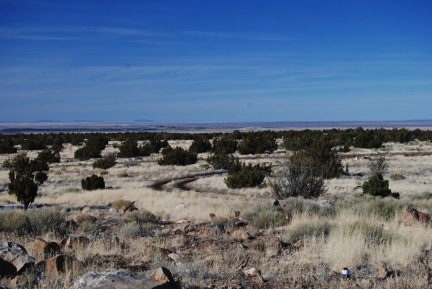 We sleep on a loft in the camping shed. There’s a wall to wall carpet up there with a mattress on top and a pair of very short night tables, one on each side. We make the bed just like we make our bed at home: with sheets and blankets and a cosy comforter. Our heads are right beneath a window that looks out on my favorite view: northwest toward Mount Trumbull.
We sleep on a loft in the camping shed. There’s a wall to wall carpet up there with a mattress on top and a pair of very short night tables, one on each side. We make the bed just like we make our bed at home: with sheets and blankets and a cosy comforter. Our heads are right beneath a window that looks out on my favorite view: northwest toward Mount Trumbull.
We usually sleep with the blinds open so we can look out at the night sky if we happen to wake in the middle of the night. On a moonless night, its very dark outside, with just a few pinpoints of light representing far-off ranches. The sky, of course, is full of stars and the glow of the milky way on most moonless nights. If it’s cloudy, we can see the reflection of the lights of Las Vegas, at least 100 miles away, on the cloud bottoms out to the west.
But the moon yesterday morning was so bright that I had to shut the blinds to get another hour of sleep.
It was cold in the shed: in the 50s. The heat was on and set to 70° but the shed, which is insulated, was no match for the 27° cold outside. I changed from my pajamas to a pair of sweatpants and a sweatshirt. Since the power level was a bit low, I made my coffee with a stovetop percolator. I heated up Alex the Bird’s scrambled eggs — which I’d made in the microwave at home before coming to Howard Mesa — in a piece of aluminum foil on top of the heater. I let Jack the Dog out and then back in. With the critters fed and Mike still up in bed, I spent some time working on a blog entry.
Toilet Woes
[Note: The following is a somewhat graphic description of a sanitary problem we’re having at the shed. If you’re easily offended by discussions of toilet operations, please skip this section.]
The toilet was not working properly. The shed has an RV toilet, which we installed because it would use less water.
Now most folks reading this probably know how a standard toilet works. There’s a fixture with a seat and a bowl and a tank on back (or up high). You do your business in the bowl and then use a handle or a pull-cord to flush. The water in the tank rushes into the bowl, flushing the bowl’s contents down the drain and filling the bowl with fresh water. Pretty basic stuff.
An RV toilet works a bit differently. There’s no tank of water. Instead, there’s a foot or hand pedal that lets you put water from your water source into the bowl. You do your business and then use the pedal to open the bottom of the bowl so the contents drop out. Clean water swooshes around the bowl to clean it a bit, but it goes down the drain, too. So the bowl is usually pretty empty between uses. The benefit of this system for an RV — or cabin where you have to haul your own water — is that you can use as much (or as little) water as you like to take care of business.
The problem with the toilet was that the valve to let water into the bowl wasn’t working. You’d push the foot pedal and the bottom would open to drop the bowl contents into the septic system, but no water would rush in to clean the bowl, etc. We used what we called “manual flush” — we kept a bucket of clean water in the bathroom and used that to add and flush water down the drain after using the toilet. Sanitation was not impaired; the bathroom was still clean and the toilet was still flushed.
And the rest of the plumbing worked fine — right down to the water heater.
We figured that the toilet’s valve had water in it that had frozen, thus preventing the flow of water. But the shed had been above freezing for close to a full day, so the chances of it still being frozen were minimal.
After breakfast, Mike worked on the problem. He removed the valve. The plastic pipe had bulged and cracked under stress where water had frozen in it. The valve was broken.
It was the day before Christmas, on a Monday. We worked the phones, using our Flagstaff phone book. The one place that was likely to have the part was closed. No other place that was open had the part.
Mike put the bad valve back on so the pedal would work. (I was not interested in reaching behind the bottom of the toilet to manually twist and untwist the valve control after using the facilities.) And we realized that we’d be on manual flush for the rest of our stay.
It seems to me that every time we come up here, something isn’t working right. Last time was the heater — Mike had to remove a mouse nest from it before it would work. On other visits, it was the water heater not relighting automatically when it should, the water pump cutting out in the middle of a shower, or cracked pipes.
It would be nice to come up here and have everything working right at the same time.
Flagstaff
We spent a good portion of the day in Flagstaff, the nearest city to Howard Mesa.
Flagstaff is a great town, with a wonderful mix of people of different ages and nationalities and backgrounds. It’s a melting pot where young and old get together to steer economic growth. So you’ll find all kinds of businesses there, from hippie gift shops smelling of incense to book shops to sporting goods shops to natural food stores. It also has all the standard big box stores, including Home Depot, Wal-Mart, Target, and Sam’s Club.
Yesterday, we went into Flagstaff for lunch, to walk around the historic downtown area, and to pick up a few odd things we needed. There was quite a bit of snow on the ground, but it had been plowed or shoveled off the roads and sidewalks, leaving scattered ice and some very impressive icicles hanging from rooflines. Traffic was lighter than usual — probably because NAU was between semesters and most of the students had gone home. We still had some trouble finding a parking spot downtown, but soon were parked on Humphrey’s.
There was a Japanese restaurant on Route 66, right around the corner, that I wanted to try. When we got there, it was closed.
We walked around town. There was a Thai restaurant at the Hotel Monte Vista. I like Thai food, but every time we’d looked into the place at lunchtime, it was empty. On that day, there were about a half dozen people inside at noon. We decided to give it a try.
Good choice. The menu was extensive, the service was friendly, and the food was served good and hot. We shared a hot pot of soup, some spring rolls, and an order of short ribs. The ribs were good, but when the guy next to me got his curry, I decided I’d try that next time. I really like curry. Meanwhile, the place filled up. It wasn’t until we left that I realized the place was under new management.
We went into Babbitt’s and a few of the other downtown shops. They were all winding down from the Christmas shopping rush. There were other shoppers, but not many.
Wal-Mart and Beyond
Mike decided that there might be a chance of finding the toilet valve at Wal-Mart, since some Wal-Mart stores stock RV parts and supplies. He talked me into going into Wal-Mart with him. The day before Christmas.
We parked on the side near the garden shop area, which was full of Christmas stuff. One step inside and my stress level rose considerably.
I’ve been in Wal-Marts before, but the one in Flag has to be the worst. It’s an older store, much smaller than the Super Wal-Marts going up all over the country. To fit all that merchandise in the store, they have very tall shelves on rather narrow aisles. The result is claustrophobic. The store was full of last-minute shoppers looking for crap from China to give as gifts or to decorate their homes.
We found the RV Accessories aisle and realized after a moment that they wouldn’t have the part we needed. I immediately went into escape mode, plotting my way out of the store with the least interaction with anyone else. Mike, on the other hand, wanted to get all the items on our little list there: a pencil sharpener, RV antifreeze (to fill drain traps when we leave), distilled water (for our solar setup’s batteries), 9v battery (for our smoke/carbon monoxide detector), hand sanitizer. That would have us running all over the store, which was not a viable option for me. So when he found the antifreeze not far from the RV Accessories, I talked him into buying just that and stopping at a supermarket for the rest.
I endured the recorded sound of dogs barking to the tune of Jingle Bells at the check out area before we emerged back into the sunshine.
We got back into the truck and drove to the nearby Basha’s Supermarket. We got everything on our list there, then headed back to Howard Mesa.
Afternoon and Evening at the Shed
Back at the shed, it was nice and toasty. The outside temperature had risen to the 40s but the sun was very strong, beating on the front of the shed and coming through the front windows. It was in the 70s in the shed. The wind was blowing lightly outside — not enough to find the cracks around the windows and the rest of the structure.
We each took good, hot showers and changed into comfortable lounging clothes. I made up a little cheese platter and opened a bottle of wine. We relaxed and read and studied IFR charts.
We each opened a present. I got a bottle of absinthe from Mike. Mike got a watch-winder cabinet from me. We had three presents left to open: two for me and one for him. I’m pretty certain there’s a small pile of presents on my doorstep at home.
Mike made some pasta for dinner. I was still full from lunch and our snack, so I didn’t eat much.
For our evening entertainment, we tried to play a DVD we’d brought along. My MacBook Pro’s CD/DVD drive is dead — I discovered that just the other day and will be sending it back to Apple for repair next week. So Mike had brought his Dell laptop. Unfortunately, it didn’t seem able to play a DVD either.
So we played dominos and listened to music.
Now this might seem boring to you. I won’t lie and say it’s exciting. What I will say, however, is that it’s restful. Our place is small and far from neighbors and paved roads. No one drives by. The only sound is the wind and an occasional coyote howl.
The only thing that could make this a nicer place to spend Christmas eve is a fireplace with a real yule log burning in it.
And a fully working toilet.

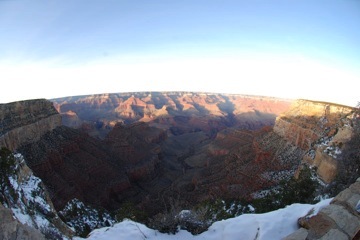 Inside the park, we got a parking spot in the small lot right near El Tovar, where we’d be eating dinner with friends. The hotel is right on the Rim, so we spent some time out on the pathway there, looking into the canyon as the sun was dipping ever lower into the southwestern sky. I played around with my fisheye lens — this was the first time I’d had a chance to use it at the Canyon — and got an interesting shot that includes the snow all around on the Rim.
Inside the park, we got a parking spot in the small lot right near El Tovar, where we’d be eating dinner with friends. The hotel is right on the Rim, so we spent some time out on the pathway there, looking into the canyon as the sun was dipping ever lower into the southwestern sky. I played around with my fisheye lens — this was the first time I’d had a chance to use it at the Canyon — and got an interesting shot that includes the snow all around on the Rim.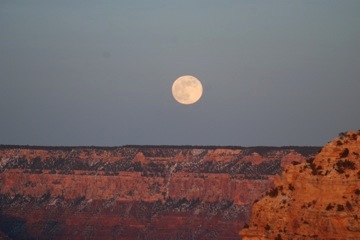 Afterwards, we came out for another peek into the canyon and were rewarded with a view of the newly risen full moon inching into the sky over the north rim. I snapped a few photos of it, but was too cold (or lazy?) to set up my tripod and do it properly, so the shots I took with my 200mm lens aren’t as clear as they could be.
Afterwards, we came out for another peek into the canyon and were rewarded with a view of the newly risen full moon inching into the sky over the north rim. I snapped a few photos of it, but was too cold (or lazy?) to set up my tripod and do it properly, so the shots I took with my 200mm lens aren’t as clear as they could be. After stopping for some photos inside the hotel lobby where a tall Christmas tree stretched up to the second floor, we stepped outside and walked back to the Rim. The moonlight was shining brightly down into the canyon, casting shadows that defined the rock walls. It was a beautiful scene, but one my camera couldn’t seem to capture properly. (I really need to play around a bit more with the bracketing feature.)
After stopping for some photos inside the hotel lobby where a tall Christmas tree stretched up to the second floor, we stepped outside and walked back to the Rim. The moonlight was shining brightly down into the canyon, casting shadows that defined the rock walls. It was a beautiful scene, but one my camera couldn’t seem to capture properly. (I really need to play around a bit more with the bracketing feature.)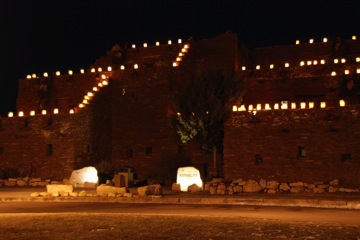 Since I was out there with my tripod, I took a few moments to photograph Hopi House and El Tovar. Hopi House was especially festive with its [electric] luminarias.
Since I was out there with my tripod, I took a few moments to photograph Hopi House and El Tovar. Hopi House was especially festive with its [electric] luminarias.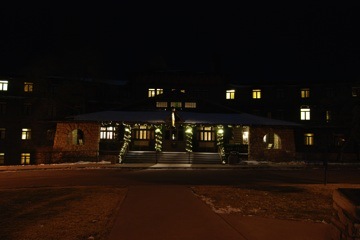 It was after 9:30 PM and it wasn’t very cold at all. The wind had died down and the air was crisp and dry. There wasn’t anyone around except us. That made good conditions for taking these photos. They create the illusion that the historic buildings along the Rim are private, special places. In reality, during the day, these places are mobbed with tourists and it would be nearly impossible to photograph them without including a few people in each shot.
It was after 9:30 PM and it wasn’t very cold at all. The wind had died down and the air was crisp and dry. There wasn’t anyone around except us. That made good conditions for taking these photos. They create the illusion that the historic buildings along the Rim are private, special places. In reality, during the day, these places are mobbed with tourists and it would be nearly impossible to photograph them without including a few people in each shot.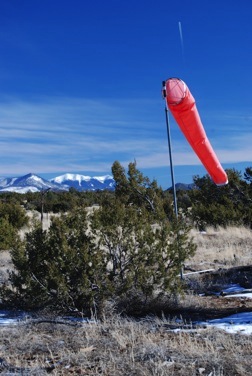 I went out for a while and took some photos. It’s so perfectly clear and beautiful outside, with just enough snow to remind you that it’s winter. There’s just a slight breeze blowing; if it picks up it’ll get very cold outside.
I went out for a while and took some photos. It’s so perfectly clear and beautiful outside, with just enough snow to remind you that it’s winter. There’s just a slight breeze blowing; if it picks up it’ll get very cold outside.
 I do recall one other monsoon-related incident, though. The company I worked for had about ten helicopters on duty to do flights. Because of this, the company was very popular with tour companies, which would bus large groups of foreign tourists to the airport for helicopter flights. These flights were booked years in advance, so the company always knew when they’d need all helicopters to fly for a single group. One of these groups arrived late in the day during August. Nine other pilots and I were sitting out on our helipads, engines running, blades spinning, when the bus pulled up. Moments later, the loaders were bringing groups of five and six Japanese tourists to the helipads and loading us up.
I do recall one other monsoon-related incident, though. The company I worked for had about ten helicopters on duty to do flights. Because of this, the company was very popular with tour companies, which would bus large groups of foreign tourists to the airport for helicopter flights. These flights were booked years in advance, so the company always knew when they’d need all helicopters to fly for a single group. One of these groups arrived late in the day during August. Nine other pilots and I were sitting out on our helipads, engines running, blades spinning, when the bus pulled up. Moments later, the loaders were bringing groups of five and six Japanese tourists to the helipads and loading us up.